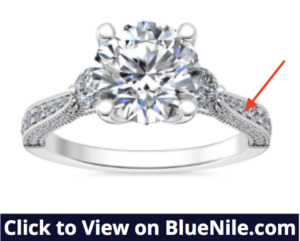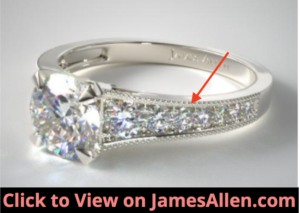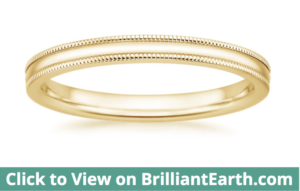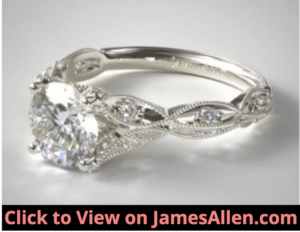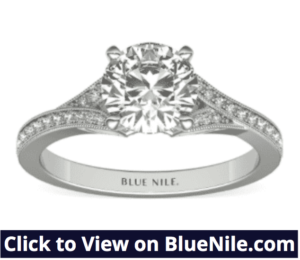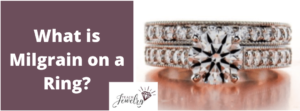
There are many techniques used to create timeless designs on your jewelry.
While the main focus of a diamond ring is the gem at its center, intricate details can come together to create a cohesive piece.
Today, we are going to look at a common element of jewelry design: milgrain.
What is Milgrain?
Milgrain (sometimes spelled “millgrain” or “milgraine”) is a popular design technique used to add detailed borders or other designs on rings or pendants in the form of tiny metal beads or dots. It’s often seen on the outside surfaces of rings to add a border of detail to an otherwise smooth surface.
Milgrain is an old design feature and was used for antique-style jewelry. As of late, it has made a comeback and is seen on various jewelry pieces common today.
To see a real example, I’ve highlighted the milgrain on this diamond ring.
Notice that even though the image is in high-resolution, it’s still difficult to spot. This demonstrates how it’s often not apparent from a distance when you’re wearing it on your finger, but when viewing the piece up close, it’s a meaningful addition.
One of the benefits of milgrain added to your new jewelry is it doesn’t always demand a higher cost.
The quality of diamond you buy is a much more significant determinant of price than milgrain, so don’t think that by choosing this option, you’re guaranteeing a huge price increase.
History
Milgrain has a rich history, dating back several centuries and likely originating in Asia. Archaeologists have discovered ancient artifacts from this region that suggest earrings were some of the first jewelry pieces to feature milgrain.
Rings were later found with milgrain years later.
Throughout the years, the technique was improved upon and demonstrated by many jewelers across the world. During the 20th century, milgrain took off and became a widely used jewelry technique.
At the time, it was reserved for wealthy people and viewed as a delicate and high-end addition to jewelry. It was mostly seen on platinum jewelry.
Jewelers developed elaborate designs with milgrain as the main feature after the invention of the acetylene torch.
During the Art Deco period, jewelers incorporated it into more jewelry.
Now, milgrain is used by nearly every jeweler and can be placed on almost any piece with enough space. While it’s not held to the high standard it used to, milgrain is still a way to make a one-of-a-kind piece because of that added touch.
How Milgrain is Designed onto a Ring
Milgrain is designed onto a ring by one of three methods. These methods include two traditional techniques incorporated by master craftsmen. The last method requires the use of computer-aided design (CAD).
All three methods create stunning designs; however, depending on the manufacturer, one or a mix of the three will be used. Let’s take a closer look at each method to give you a better idea of how they work.
The first method involves crafting each tiny bead by hand and then hand-soldering them onto the jewelry piece. Due to the time-consuming, detail-oriented process this technique requires, it is only used by master craftsmen. It’s usually reserved for custom pieces of higher value.
The second technique requires a knurling tool. The knurling tool is similar to a small pizza cutter and is used to hand-press the milgrain into jewelry. This requires the specialized-hand of an experienced craftsman to ensure it’s transferred correctly.
Lastly, the simplest and most modern process is through CAD. The jeweler designs the milgrain in the CAD program, and then it is transferred to a wax mold. Cast metal is poured into the wax mold to create milgrain jewelry.
While this is the easiest method, and most cost-effective, it lacks the intricacy found on handcrafted designs.
What are the Benefits of Milgrain?
1. Adds Texture
Since milgrain adds tiny dots to your jewelry, it then has a new texture. The dots are raised parts on your jewelry, which adds dimension and a custom, intricate look.
Take a look at the wedding ring below, and identify how milgrain runs on both sides.
It contrasts with the smooth metal found in the middle.
With its vast history, the texture of milgrain can add a vintage look to the most modern of pieces. The texture on jewelry can help your ring, earrings, or pendants stand out from others.
2. Frames Gemstones
Milgrain can be used as a frame for gemstones, giving your ring an even more custom look.
Gems added to the ring are usually encased by a metal gemstone holder. Milgrain can be used instead to complement its features and depth.
A halo design, with milgrain wrapped around the gem, results in a perfect transition from the metal beads to the center stone.
3. Creates A Border For Rings
A popular reason milgrain is used on rings is to add a border around it. Rings are usually flat or concave, leaving much to be desired on the simplest of designs.
A border of milgrain helps accent the overall look of an engagement ring or wedding band. It can turn a basic look into a custom jewelry piece designed by a master craftsman.
You can also use it to border other items in the ring such as diamonds or other accents.
Problems with Milgrain
The biggest problem with adding milgrain to a ring is it must be maintained to preserve its detail. Over time, depending on how it’s worn, milgrain can wear down, causing it to slowly disappear.
This can be remedied by taking your ring to a professional jeweler for milgrain restoration. Fortunately this should only have to be done once every several years.
Additionally, due to the texture and depth that milgrain adds, dirt, grime, and debris can become lodged into the valleys of the milgrain.
Depending on the amount your ring is exposed, it may hold more dirt than rings without it. This can be avoided by regularly cleaning your ring and its milgrain to ensure that it is properly maintained.
If neglected, the dirt and grime slowly wear down the metals used in your ring, causing your ring to dull around the milgrain. If you don’t feel comfortable cleaning your jewelry, consider taking it to a professional for cleaning regularly.
Types of Designs with Milgrain
Wedding Rings
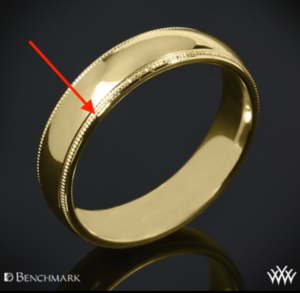
Though the beads are often metal, milgrain doesn’t have to be silver. Whiteflash offers a 14K yellow gold wedding ring with milgrain. While you might assume the milgrain adds a level of discomfort, this “comfort fit” band is designed specifically for everyday wear.
The milgrain wraps around the entire ring on the top and bottom and would be a perfect match for an engagement ring that also includes milgrain.
Engagement Rings
The milgrain on the above engagement ring runs alongside pave set brilliant diamonds. The uniqueness in this ring is in the intricate details, with milgrain beads arching up and down before arriving at the center stone.
It’s proof milgrain doesn’t have to only run in a circle around the shank. It can be fashioned into patterns that surround multiple diamonds — in this case, round or cushion.
Pave
The milgrain on the diamond engagement ring above runs along the v-shank to meet the top and bottom of the round diamond. It’s placed on the 14K white gold along with the brilliant pave diamonds that lead to the center stone.
While some shanks might feature either pave diamonds or milgrain, this ring is the right fit for someone who doesn’t want to hold back on the sparkle, even when it’s not involving the main diamond.
What to Consider When Buying Jewelry with Milgrain
When purchasing jewelry with Milgrain, there are a few aspects to keep in mind.
Maintenance: The most important aspect you will notice with jewelry that contains milgrain is you will have to maintain it more often than other jewelry. The fine details make it easier for particles to become lodged in the jewelry, meaning you will have to clean the ring more often. You can easily clean your jewelry with warm water, a mild soap, and a very soft brush.
Lifespan: Since milgrain is made from tiny beads of metal, the milgrain will wear down eventually. Since you will only need to have it restored once a decade, this isn’t too big of an issue, but it is certainly something you will want to consider when purchasing jewelry with milgrain.
Design: There isn’t just one type of milgrain for a ring. Because it’s a custom addition, there are many design options to choose. Whether gold or silver beads or large or small, you can add dazzle to your ring any way you want it.
Conclusion
Milgrain is a unique addition to any ring and is found on a variety of them, whether engagement rings, cocktail rings, or wedding bands. It’s a special touch that won’t draw attention away from the main gem but instead embellishes the shank to ensure each part of your ring is special.
Q&A Section: Milgrain on Jewelry
Q1: How does milgrain enhance the appearance of shared prong or pave settings on rings?
A1: Milgrain can add a vintage or intricate look to both shared prong and pave settings by creating a detailed border around the diamonds or along the edges of the ring. This subtle yet elegant detail adds texture and dimension, making a ring with shared prong or pave setting appear more unique and finely crafted.
Q2: How can milgrain complement other vintage features on jewelry?
A2: Milgrain can enhance other vintage features like filigree work, scrollwork, or engraved details by providing a textured border that highlights these elements. Moreover, when combined with antique-cut gemstones or old-world designs, milgrain can contribute to a cohesive vintage aesthetic.
Q3: How does the longevity and maintenance of milgrain compare to that of other intricate designs like filigree?
A3: Both milgrain and filigree require regular maintenance to preserve their intricate details. However, milgrain might wear down over time and may need professional restoration, while filigree, depending on its depth and craftsmanship, might retain its design for a longer period. Regular cleaning is essential for both to prevent dirt and grime accumulation which could potentially accelerate wear.
Q4: Are there modern interpretations of milgrain design, and how do they differ from traditional milgrain?
A4: Modern interpretations of milgrain may utilize computer-aided design (CAD) to create more precise or geometrically-aligned milgrain detailing. While traditional milgrain often has a handcrafted charm, modern milgrain can offer a more uniform or contemporary look, blending the vintage appeal with modern design aesthetics.
Q5: Can milgrain be added to a ring post-purchase, and what is involved in this process?
A5: Yes, milgrain can be added to a ring post-purchase by a skilled jeweler. The process may involve hand-tooling or using a knurling tool to create the milgrain detailing. However, the feasibility and cost of this process would depend on the existing design of the ring and the expertise of the jeweler.
Q6: How does the choice of metal for milgrain impact its appearance and durability?
A6: The choice of metal can significantly impact the appearance and durability of milgrain. Metals like platinum or palladium might offer better durability and a crisp appearance for milgrain, while gold provides a classic or warm look. The metal’s hardness and color will affect how the milgrain ages and contrasts with the rest of the jewelry piece.
Q7: What types of jewelry aside from rings commonly feature milgrain, and how does it enhance their design?
A7: Milgrain is also commonly found on earrings, pendants, and bracelets. On these pieces, milgrain can add texture, frame gemstones, or provide a border that enhances the overall design. By adding a level of intricacy, milgrain can transform a simple jewelry piece into something more elegant and eye-catching.
Q8: How do different cultures interpret or use milgrain in their jewelry designs?
A8: Milgrain’s origins trace back to Asia, and over centuries, different cultures have embraced and adapted milgrain to their aesthetic preferences. The design’s use and interpretation might vary, reflecting local artistic styles, jewelry traditions, and historical influences. Milgrain’s universal appeal lies in its ability to add detail and texture, making it a cherished design element across different cultures.
It’s also an update that won’t break the bank.
When choosing milgrain for a ring, consider the maintenance it may require, but mostly focus on its exact design and how it can add a new style.

Jacob Clarke
Jacob Clarke is the founder of TeachJewelry.com.
He earned an Applied Jewelry Professional Diploma from the Gemological Institute of America (GIA) and now brings you essential information about diamonds, settings, and more.
Jacob has consulted with leading jewelry brands, and his work has been cited in Clean Origin, Diamond Nexus and industry publications.
He's also a member of the International Gem Society.
He enjoys discussing jewelry with readers, so contact him with any questions at jacob.clarke@teachjewelry.com.

